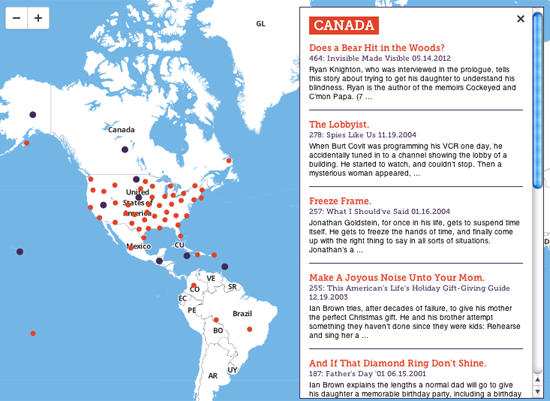Data journalism and information visualization is a burgeoning field. Every week, Between the Spreadsheets will analyze, interrogate, and explore emerging work in this area. Between the Spreadsheets is brought to you by CJR and Columbia’s Tow Center for Digital Journalism.
Data isn’t always a number. It can be more abstract — an mp3 file, for example. Thus, a radio show’s archive can be considered a database. This American Life‘s Story Globe is a mapped version of its archive, a geographical representation of its podcasts:

Displaying stories in this way puts a completely different spin on TAL’s archived content. It provides a more engaging entry point into their radio pieces. The stories are arranged on a global map by the cities, countries, or states tagged to them. The design is clean and elegant; a red dot denotes stories related to a city, and a purple dot represents countries or states. Clicking on a dot causes a box to pop up in the top right-hand corner of the map that displays the stories from that location with a short blurb and a link to individual landing pages. On those pages, the options to download or stream the podcast are available, along with a transcript of the show.
The map allows users to search for stories related to specific geographic locations, and it’s an interesting exercise in visualizing the number of stories tagged to certain areas. For example, New York has dozens of entries, while the Virgin Islands has just one.
With a repository of weekly shows dating back to its first broadcast on November, 17 1995, arranging the podcasts chronologically isn’t the most appealing method. That being said, it forms a necessary part of a wider range of search options. There are occasions when a chronological search is useful — for example, when a user knows the exact air date of a podcast he or she is after.
There should be a logic to the structure of a database. In this case, the key element in TAL’s archive architecture is its astuteness to the needs of its user. While some users are looking for a specific show on a specific date, others may be interested in finding something from a particular contributor.
Users are also able to explore stories by categories. A list of tags associated with the shows is arranged alphabetically for listeners to explore TAL’s back catalog.
For TAL, one of the main advantages of maintaining such a well-organized database is user engagement. Offering four different ways to explore its podcasts increases the reach and appeal of those stories. It’s an “open” approach to journalism that encourages community participation.
A topical, feature-based radio show is not the kind of journalism that immediately springs to mind when thinking about the use of data in newsroom. However, when news organizations consider how they should be working with data, writing data-driven narratives is not the only option. By producing shows that deal with evergreen topics and have a long shelf life, TAL has its own dataset, comprised of its stories. Storing them in a database is a straightforward way of archiving content. Arranging that database in a non-traditional format really brings those stories to life.
Anna Codrea-Rado is a digital media associate at the Tow Center for Digital Journalism at the Columbia University Graduate School of Journalism. Follow her on Twitter @annacod.
